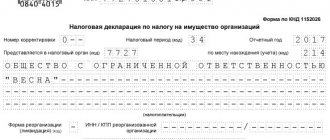All articles
69856
2020-03-12
One of the mandatory fees for Russian citizens is the tax when purchasing real estate, the amount of which is calculated based on the algorithms specified in the current legislative documents. We will tell you in more detail about how to calculate property taxes in 2021 in this article.
Owners of apartments, dachas, private houses, apartments, parking lots, garages, industrial and commercial premises, unfinished buildings and other construction projects, data on which are entered into the unified database of the Federal Tax Service of the Russian Federation, are required to pay such a fee.
The legislative framework
Real estate taxation is a mandatory fee established by government law. It obliges individuals and legal entities who have Russian citizenship and have reached the age of eighteen to pay taxes on property assets.
According to Federal Law No. 2003-1, which was in force until January 1, 2015, in order to calculate real estate tax, it was necessary to conduct an inventory assessment. Based on the value received, the tax rate was calculated.
Since 2015, new amendments have been added to the Tax Code of the Russian Federation, based on which the procedures for calculating the tax have radically changed, which has significantly increased the burden on citizens. Now the tax on the purchase of real estate should be determined based on the price indicated in the extract from the Unified State Register or a certificate of cadastral value.
Important!
You can find out the cadastral value (inventory valuation) by ordering an extract from the Unified State Register on our website.
According to statistical data, the price of an object according to such an extract is approximately equal to its price on the real estate market. However, if the owner does not agree with the price assigned by the cadastre, then he has every right to challenge the valuation of the property in court.
Results
The definition of “property tax,” according to the Tax Code of the Russian Federation, applies to two types of payments: those paid by legal entities and those paid by individuals. The basic application rules for these taxes, prescribed in the Tax Code of the Russian Federation, are characterized by significant similarities. But there are also differences, including the issue of establishing deadlines for transferring payments to the budget. For the tax on individuals, there is a single deadline for the entire country, specified in the Tax Code of the Russian Federation and subject to the rule of transferring it to a later date if it coincides with a weekend. Payments for 2021 will have to be made to individuals no later than 12/01/2021.
The procedure for paying tax from legal entities has options. Tax may be paid:
- one-time based on the results of a declaration drawn up at the end of the year, if the region refused to divide the tax period into reporting periods;
- in 4 doses (at the end of reporting periods and after the end of the year).
However, whatever procedure turns out to be valid, the region will set the deadlines for transferring tax payments independently. Therefore, you can find out the specific dates of such deadlines only from the law of the subject of the Russian Federation.
Sources: Tax Code of the Russian Federation
You can find more complete information on the topic in ConsultantPlus. Free trial access to the system for 2 days.
What formula is used?
Algorithms for calculating tax collection are established by federal legislative documents. You can calculate the amount of property tax using the following formula:
Tax fee = (Cost according to extract from the Unified State Register - Tax deduction) x Share size x Tax rate
In order to fully use the calculation formula, you need to find out in advance the price according to the cadastre, which is indicated in a special extract from the Unified State Register of Real Estate. In addition to this information, the extract contains information about the owner of the object, drawings and diagrams of the object, as well as other important information about the property.
Below we will consider the remaining components of the form that will be required to carry out the calculations.
Tax deduction
This indicator is represented by the amount deducted by the owner from the total tax amount. Within the Russian Federation, this is profit subject to a tax rate of 13%.
The amount of compensation is determined based on the type of object subject to tax:
- for private houses - the cost is compensated 50;
- for apartments – 20;
- for rooms – 10.
It is important to take into account that the regional government can set the amounts of deductions that differ from the state ones. Before applying for compensation, it is recommended to study the legislation of the region in which you are located.
Tax rate
This indicator is one of the most significant components of the formula. Municipal authorities of each region set their own rates. You can find out its size by contacting the local branch of the Federal Tax Service or by visiting the official website of the Federal Tax Service, selecting the region in which you are located.
It is important to consider that the calculated rate cannot be more than:
- 0.1% – for parking spaces, garages, unfinished buildings and residential buildings;
- 0.1-0.3% – real estate priced from 300 to 500 million rubles;
- 0.3-2.0% – for property exceeding the price of 500 million rubles.
Who should pay property tax?
The obligation to pay the tax fee annually is assigned to individuals in whose name the following objects are registered:
- private houses;
- parking spaces or garages;
- rooms;
- apartments;
- real estate complexes;
- unfinished;
- other types of real estate.
Note! Public facilities (elevators, basements and attics, roofs and staircases) are not subject to fees, since they are not assigned to any specific owner, but are public property. The right to use these facilities is granted to all residents.
Taxation applies to buildings erected on land plots allocated for gardens and vegetable gardens, as well as non-commercial subsidiary farming and individual housing construction. This means that such owners are obliged to pay a fee, the amount of which is equal to the standard taxation of residential properties.
Who pays the fees?
The responsibility to transfer money to the budget rests with those who own the following objects:
- With unfinished construction.
- Real estate complexes, in a single form.
- Apartments, rooms of residential buildings.
- Garages, places for cars.
- Residential buildings.
Buildings of another type may be residential. An example is objects on plots whose purpose is individual construction, gardens and vegetable gardens, subsidiary farming. In simple words – dacha houses, garden buildings are also residential. Which leads to the use of a general taxation option.
Taxation does not include so-called common property among objects, including:
- Basements of residential buildings.
- Stairs.
- Roofs.
- Elevators.
- Attics.
Calculation of property tax based on cadastral value
The obligation to calculate property taxes for individuals and convey information to taxpayers is the direct responsibility of the Federal Tax Service. Notifications are sent to the addresses of property owners.
According to the latest amendments to the current legislation, the fee is calculated based on the cadastral value determined by the regional authorities. The final transition to the updated tax system is planned from 01/01/2021. This period is set aside for a comfortable transition to a new property valuation technology for all property owners.
What is subject to property tax
The following types of real estate are subject to property tax (Article 401 of the Tax Code of the Russian Federation):
- room in a communal apartment;
- apartment or part thereof (in case of shared ownership);
- residential cottage;
- country house;
- owned garage or parking space;
- unfinished objects;
- non-residential premises and buildings, including warehouses.
- an integral real estate complex, which includes at least one residential premises.
- outbuildings erected on a land plot allocated for individual housing construction, provided that they occupy an area of no more than 50 square meters.
Help: The calculation is made for each property separately, even if one individual owns several apartments.
Video: Property Tax Questions and Answers
An example of calculating tax based on cadastral value
To understand how to correctly calculate property taxes for 2020, let’s look at the taxation procedure using a specific example.
For example, citizen N. is a shared owner in an apartment. His share is 50%. Real estate with an area of 100 is valued according to the cadastral passport at 6,000,000 rubles. According to current federal laws, the tax deduction for such housing will be 2,400,000. The municipal authorities have set a rate of 0.1%.
You can determine the amount of the tax fee by substituting the available data into the formula:
Tax = (6,000,000 - 2,400,000) x 0.001x 0.5
After doing the calculations, you can determine that the amount of the fee to the Federal Tax Service will be 1,800 rubles.
To carry out calculations with maximum accuracy, perform the calculation several times. When working with a formula, it is important to use only the data that is relevant today.
Note! The estimated cadastral value must be taken into account before calculating the tax on the sale of real estate.
How the rate will change depending on the region
Not all regions calculate property tax based on cadastral value. Many people still use only the inventory price when calculating it. The list of subjects will increase every year, and by 2021 all of Russia will switch to new taxation.
Expert opinion
Roman Efremov
5 years of experience. Specialization: all areas of jurisprudence.
In 2021, the average tax rate for an apartment in Russia is 0.1%. This indicator is enshrined in the current norms of the Tax Code. At the same time, regional and municipal authorities have the right to correlate the rate. If desired, local property tax payments can be completely waived, and the maximum allowable rate is 0.3%.
The property tax rate differs in the regions of Russia
To calculate the property payment in Moscow and St. Petersburg, a transitional formula is used using both the cadastral and inventory values of the apartment. Moreover, each subject of the Russian Federation sets its own rate, which depends on the object of taxation and its value.
For Moscow, the property tax rate is presented in the following table:
| Real estate objects | Cost (million rubles) | Bid (%) |
| Living spaces | to 10 | 0,1 |
| from 10 to 20 | 0,15 | |
| from 20 to 50 | 0,2 | |
| from 50 to 300 | 0,3 | |
| over 300 | 2,0 | |
| Garages | 0,1 |
Other rates accepted in St. Petersburg:
| Property | Cost (million rubles) | Bid (%) |
| Residential buildings | up to 5 | 0,1 |
| from 5 to 10 | 0,15 | |
| from 10 to 20 | 0,2 | |
| from 20 to 300 | 0,25 | |
| Apartments | up to 7 | 0,1 |
| from 7 to 20 | 0,15 | |
| from 20 to 30 | 0,2 | |
| over 300 | 2,0 | |
| Garages | 0,3 |
For the Saratov region, property tax for 2021 is calculated based on the inventory price. But from January 1, 2019, its calculation is introduced at the cost established by the cadastre service. A rate of 0.3% applies to all apartments and rooms; for residential buildings it is 0.15%.
In the Kaliningrad region the following rates apply:
| Property | Cost (million rubles) | Bid (%) |
| Residential buildings and premises | up to 300 | 0,05 |
| over 300 | 1,0 | |
| Garages | 0,3 |
To calculate property tax in Omsk, the following rates are established:
| Property | Cost (million rubles) | Bid (%) |
| Residential buildings | up to 300 | 0,3 |
| Apartments | up to 300 | 0,1 |
| Living spaces | over 300 | 2,0 |
| Garages | 0,3 |
Features of calculating property tax during the transition period
Not all regions of the Russian Federation have yet switched to this form of tax collection calculation. According to the Federal Tax Service's plans to calculate property taxes in 2020
under the new system there will be 7 more new regions.
Since the state system is currently undergoing a transition process, the law officially allows the use of a deterrent coefficient. For the current year, the size of the mentioned coefficient is 0.8, which is equal to last year’s figure. Such rules apply exclusively for this year and cannot be applied to calculate real estate tax based on cadastral value in 2021 and subsequent years. From the beginning of 2021, owners will be required to pay the full rate.
Calculation of tax on cadastral value
Tax calculation based on cadastral value has its own peculiarity. It lies in the fact that there are transitional rules for calculation.
Transitional rules apply to all property, except for objects included in the approved regional list or formed from them (clause 8 of Article 408 of the Tax Code of the Russian Federation).
Tax calculation without taking into account transitional rules
For objects from regional lists, the inspectorate will calculate the tax using the following formula:
| Tax amount for the current year for the object | = | The tax base | × | Tax rate applicable at the location of the property for the current year |
This formula is suitable for calculating tax for a full year. If you need to calculate tax for an incomplete year, then continue the calculations by applying special rules.
When there are several such objects, calculate the tax separately for each of them. And then determine the total amount of personal property tax for the current year:
| Amount of property tax for individuals for the current year | = | The amount of property tax for individuals for the current year for object No. 1 | + | The amount of property tax for individuals for the current year for object No. 2 | + | The amount of property tax for individuals for the current year for object No.... |
This follows from the provisions of paragraph 1 of Article 408 of the Tax Code of the Russian Federation.
Calculation of tax according to transitional rules
The essence of the transitional rules is as follows. During the first four years from the year in which local authorities decided to calculate the tax at the cadastral value, reducing factors are applied.
Thus, for objects for which the tax is calculated based on the cadastral value, but which are not included in the approved regional list (not formed from them), the inspectorate will calculate the tax as follows:
| Tax amount for the current year for the object | = | Tax amount based on cadastral value without taking into account transitional rules | – | The tax amount based on the inventory value for the last year of application of this method | × | Coefficient | + | The tax amount based on the inventory value for the last year of application of this method |
The amount of tax based on the inventory value for the last year, when the year was 2014, is calculated according to the previously valid rules.
The coefficient values are given in the table:
| Year from the date of introduction of tax calculation based on cadastral value | Coefficient value |
| 1st year (i.e. the year from which the procedure for calculating tax based on cadastral value was introduced) | 0,2 |
| 2nd year | 0,4 |
| 3rd year | 0,6 |
| 4th year | 0,8 |
If the amount of tax based on the cadastral value without taking into account transitional rules is less than the amount of tax based on the inventory value, the tax will be calculated without taking into account transitional rules.
This procedure is established by paragraphs 8 and 9 of Article 408 of the Tax Code of the Russian Federation.
An example of checking the calculation of property tax for individuals for 2015 based on the cadastral value
A.S. Glebova owns an apartment with a total area of 120 square meters. m. On the territory where the apartment is located, from January 1, 2015, a new procedure for calculating property tax for citizens was introduced - based on the cadastral value.
The cadastral value of the apartment as of January 1, 2015, according to Rosreestr, is 10,650,000 rubles. Depending on the location of the apartment, for residential premises whose cost is above 1,000,000 rubles, the rate is 0.1 percent.
The amount of tax that Glebova was assessed for 2014, based on the inventory value of the apartment, amounted to 7,194 rubles.
In this territory, 2015 is the first year of the transition period.
The amount of tax on the cadastral value of an apartment, taking into account the deduction, but excluding transitional rules, is equal to:
8875 rub. ((RUB 10,650,000 – RUB 10,650,000: 120 sq. m. × 20 sq. m.) × 0.1%).
This is bigger. than the tax amount based on the inventory value (RUB 7,194). Therefore, the inspectorate applied the coefficient and calculated the final amount of tax payable as follows:
7530 rub. ((8875 rub. – 7194 rub.) × 0.2 + 7194 rub.).
The above procedure is suitable for calculating tax for a full year. If you need to calculate tax for an incomplete year, then continue the calculations by applying special rules.
This procedure is established by paragraph 8 of Article 408 of the Tax Code of the Russian Federation.
Tip: If you want to find out in advance how much tax you will have to pay in 2021 for 2015, use a special service on the website of the Federal Tax Service of Russia.
Calculation according to the new rules for the first 4 years
For situations where the amount on the cadastral passport (CP) is greater than the inventory value (IV), the government has developed a special calculation form that helps reduce the rapid increase in the tax burden. Miscalculations are made by substituting data into the formula:
Tax burden = (Amount for CP - Amount for IP) x coefficient + Amount for CP
These rules will be relevant until 2021. From the beginning of next year, all calculations will be performed exclusively based on cadastre data.
Tax calculation when donating real estate
This is one of the most complex procedures encountered in the legal field. It is important to realize that not all citizens will need it, since persons on whom the deed of gift is registered are exempt from taxes:
- minors;
- brothers and sisters;
- parents;
- grandparents;
- grandchildren;
- guardians.
If, when donating real estate, you do not fall into any of the categories listed above, then you will need to pay the tax fee for the gifted real estate in full.
According to current legislation, calculations when registering a donation can be made both according to the cadastral value and according to the amount specified in the deed of gift. When carrying out such a procedure, it is important to know the following points:
- the deed of gift may indicate the estimated amount of the property or its share. In such a situation, experts will compare the price according to the cadastre and the price proposed in the donation agreement;
- if the deed of gift price is less than 70% of that indicated in the cadastral department, calculations are made based on 70% of the cadastral price;
- a citizen receiving property under a deed of gift must provide the Federal Tax Service with a 3-NDFL declaration no later than April 30 of the following year. In some cases, filing a return is not associated with paying tax. Such features are established by municipal authorities, and you can find them out directly at the Federal Tax Service at your place of residence.
Tax calculation during the transition period: features
The burden of the tax plan increases when relying on the value according to the cadastre. Mitigating the situation is the main goal of introducing a transition period. The reduction factor is in effect in some regions, starting from the moment the new rules are introduced. This reduction remains in effect for the first four years.
Calculation for this time is carried out according to the formulas:
N = (Hk – Ni) x K + Ni
- K – reduction coefficient, easing the burden on citizens.
- Neither – when the support is the inventory price.
- NK – tax based on cadastral value.
The coefficient differs in the following values:
- 0.2 – for 1 year.
- 0.4 – second year.
- 0.6 – for the third year.
- 0.8 – during the last 12 months of the transition period.
They plan to increase taxes by 20% per year, but a gradual transition will make the process quite soft.
But the use of such a scheme is permissible if the tax at the cadastral value is greater than the similar indicator based on inventory data.
Calculation of property tax for individuals
Algorithms and formulas by which the tax on non-residential real estate and residential property of individuals can be calculated are prescribed in federal legislation. Detailed information about calculation methods and detailed formulas have been presented above.
However, some categories of citizens are exempt from paying real estate taxes. This right is enshrined in state laws and applies to all persons with Russian citizenship who belong to certain categories of citizens.
Tax on real estate of individuals: objects of taxation
The corresponding object for the property tax of individuals may be (clause 1 of Article 401 of the Tax Code of the Russian Federation):
- separate residential building (including country houses);
- separate living space (in the form of an apartment or room);
- garage, parking space;
- building or structure for other purposes;
- unfinished construction;
- a complex of real estate objects of a single purpose.
The common real estate of an apartment building cannot be recognized as an object of taxation (clause 3 of Article 401 of the Tax Code of the Russian Federation).
Benefits for individuals
The amendments made to federal laws practically did not affect preferential categories of citizens who are exempt from paying property taxes. The right to the benefit can be used only for one object in each of the real estate groups.
From 03/01/2015 the following were exempted from property tax:
- citizens who have lost their breadwinner while serving;
- family members of military personnel who died in the line of duty;
- creative workers working in equipped premises (studios, galleries, libraries, exhibitions, etc.);
- owners of living space up to 50, built on plots allocated for the organization of gardens, vegetable gardens and other subsidiary farming (only if the results of such farming are used for personal purposes);
- pensioners (60 years old for men and 55 years old for women) receiving benefits from the state;
- persons affected by the Semipalatinsk radiation disaster;
- combat veterans;
- citizens who took part in the Second World War and Civil Wars, as well as persons who survived other military actions to defend the Soviet Union (headquarters employees, intelligence officers, etc.);
- Heroes of the Soviet Union and the Russian Federation, having the Order of Glory of three degrees;
- military personnel who went through Afghan combat operations;
- military personnel who have served at least 20 years and were transferred to the reserve due to age;
- persons who defended populated areas during the Second World War (the list is specified in the legislation).
Preferential benefits are provided only after submitting an application and consideration of the candidacy. You can submit an application for benefits to the Federal Tax Service at your place of residence. To confirm your right to claim tax exemption, you will need to provide a certain list of documentation.
Rule 4 – Tax period
The property tax rate for individuals in 2021 based on cadastral value is set for the tax period. But what if you became the owner of property, let’s say, only in November 2021? Do you really have to pay tax for the whole year?
If you purchased property, then you also acquired the need to pay tax on it, but only from the moment of acquisition. That is, when calculating the tax, the tax authorities will take into account how many full months you own the property (if the property was purchased before the 15th day of the month, then this month will be counted as full) and you will have to pay the tax only for the months of ownership (the total tax amount is divided by 12 months and multiplied by the number of months you own).
Commercial real estate tax calculation
Real estate used by the owner for business purposes that generate income for the owner is also subject to taxes. The category of commercial property includes:
- residential premises for rent;
- shopping and entertainment centers;
- office and administrative premises;
- restaurants, bars and cafes;
- catering canteens;
- warehouses;
- workshops, etc.
The tax on commercial real estate must be calculated by taking into account its average annual value, or at the price indicated in the cadastral passport. For cadastre calculations, the tax rate is taken, the amount of which, as well as the payment deadlines, is determined by the municipal authorities. The same scheme is used to answer the question of how to calculate sales tax on commercial real estate. When selling, the cost according to the cadastral passport is taken into account.









